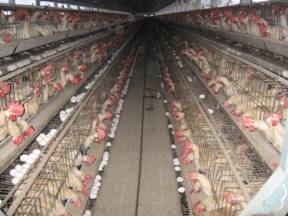 |
|||||||
| Major Activities |
Poultry :: Chicken :: Hatching of Eggs |
||||||
HATCHING OF EGGS Hatching of eggs refers to the production of baby chicks. In early days eggs were hatched by placing them under broody hens. Desi hens proved to be ideal for this purpose. Only 10 to 12 eggs can be put under 1 hen. This method of hatching is highly unsatisfactory for large-scale production of baby chicks. Incubators, which provide similar environment as that of broody hens, but more efficiently, are used at present for hatching of eggs.
Incubation The physical factors necessary for successful incubation are temperature, humidity, gaseous environment and turning of eggs. Optimum and uniform temperature inside the incubator is very essential for obtaining satisfactory results. The incubator temperature should be maintained as recommended by the manufacturer. It usually varies from 99.5° to 100.5°F (37.2°C - 37.8°C) for forced draft-type incubators and about 1°F higher for still-air incubators. Low temperature slows down the development of embryo and higher than optimum temperature hastens the embryonic development. When abnormal temperature conditions extend over a long period, hatchability is adversely affected by increase in embryonic mortality and weak and deformed chicks. Humidity in the incubator affects hatchability. Dry and wet bulb thermometers are used for measuring humidity. In fowls egg takes about 21 days to hatch. The relative humidity should be around 60 per cent during the first 18 days of incubation and 70 per cent in the last 3 days for optimum hatchability. In the forced draft-type incubators the· temperature requirement decreases as the humidity increases. Fertile eggs are loaded into the incubator with broad end up. Hatchability decreases when eggs are placed in the incubator with narrow end up as the embryo develops with its head in the small end . Turning or eggs in the incubator improves hatchability. Eggs should be turned at least 4 times during a day when turning is done by hand. Modem incubators are provided with devices for automatic turning of eggs at least 8 times or more during 24 hours. In this egg trays turn through an angle of 90°. No turning is required after 18 days of incubation. Use of separate hatcher improves hatchability. When separate hatcher is used temperature is maintained at about 98°F and relative humidity at 70 to 80 per cent to obtain good hatch. Use of separate hatcher facilitates cleaning, disinfection and fumigation without disturbing other eggs. Testing of Incubated Eggs The eggs are candled from fifth to seventh days of incubation to remove infertile eggs and on 18th day to remove dead germs. Although infertile eggs or eggs with dead germ do not serve any useful purpose, removal of such eggs from the incubator makes the room available for setting of more eggs. In most commercial establishments, candling is done on 17th or 18th day of incubation to save labour. Depending upon the passage of light through the egg, the eggs are classified as infertile when transparent, dead germ when translucent and eggs with live embryos when opaque. Eggs with live embryos only are transferred to the hatcher. For pedigree hatching of eggs they are to be set sire and dam wise in the incubator and also should be placed in the hatcher compartment wise, one compartment for each dam.
( Source: KVK, Namakkal ) Hatchery Management At the beginning of hatching season the incubator and hatchers should be thoroughly checked for their functioning and defects, if any, rectified. They should be properly cleaned, disinfected and fumigated to kill disease organisms before storing and after transfer of eggs to the hatcher. This reduces the incidence and spread of diseases. Fumigation is usually done with formaldehyde gas using 40 ml of 40 per cent commercial formalin and 20 g of potassium permanganate for each 2·8 m3 of space inside the incubator or hatcher. Potassium permanganate may be placed in a glass or earthenware container and formalin poured over it. Fumigation should preferably be done-at the end of the working day and then the rooms closed. It is a good practice to start the incubator and the hatcher at least 24 hours before setting the eggs to maintain a constant temperature. Persons working in the hatchery should use showers, and change clothes and shoes before entering. Receipt of eggs from the farm and the delivery of chicks should be away from each other to reduce infection. When electric supply is uncertain use of a standby generator is advocated.
|
|||||||
Technologies |
|||||||
Veterinary Services |
|||||||
| Home | Success Stories | Publication | Gallery | Forms | FAQs | Related Links | Contact | |
|||||||
| © All Rights Reserved. TNAU-2008. |
|||||||

